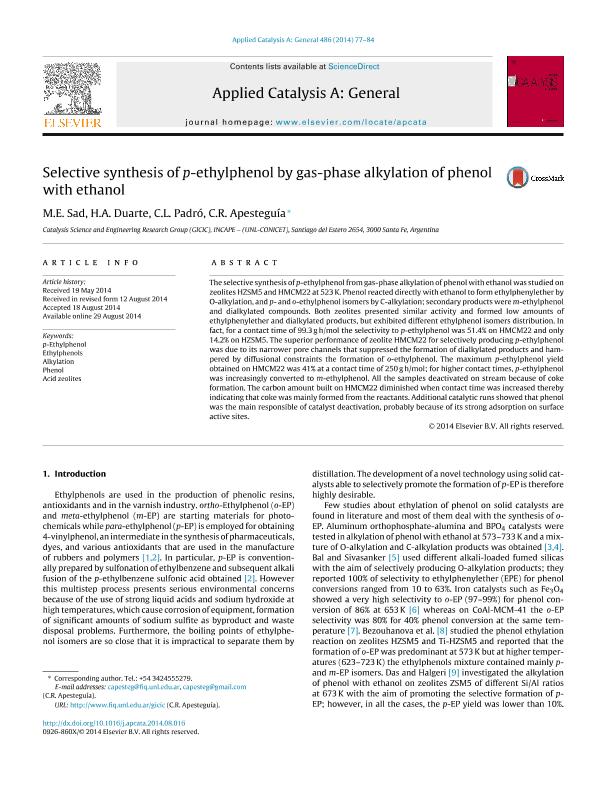Artículo
Selective synthesis of p-ethylphenol by gas-phase alkylation of phenol with ethanol
Fecha de publicación:
08/2014
Editorial:
Elsevier
Revista:
Applied Catalysis A: General
ISSN:
0926-860X
Idioma:
Inglés
Tipo de recurso:
Artículo publicado
Clasificación temática:
Resumen
The selective synthesis of p-ethylphenol from gas-phase alkylation of phenol with ethanol was studied on zeolites HZSM5 and HMCM22 at 523 K. Phenol reacted directly with ethanol to form ethylphenylether by O-alkylation, and p- and o-ethylphenol isomers by C-alkylation; secondary products were m-ethylphenol and dialkylated compounds. Both zeolites presented similar activity and formed low amounts of ethylphenylether and dialkylated products, but exhibited different ethylphenol isomers distribution. In fact, for a contact time of 99.3 g h/mol the selectivity to p-ethylphenol was 51.4% on HMCM22 and only 14.2% on HZSM5. The superior performance of zeolite HMCM22 for selectively producing p-ethylphenol was due to its narrower pore channels that suppressed the formation of dialkylated products and hampered by diffusional constraints the formation of o-ethylphenol. The maximum p-ethylphenol yield obtained on HMCM22 was 41% at a contact time of 250 g h/mol; for higher contact times, p-ethylphenol was increasingly converted to m-ethylphenol. All the samples deactivated on stream because of coke formation. The carbon amount built on HMCM22 diminished when contact time was increased thereby indicating that coke was mainly formed from the reactants. Additional catalytic runs showed that phenol was the main responsible of catalyst deactivation, probably because of its strong adsorption on surface active sites.
Palabras clave:
P-Ethylphenol
,
Ethylphenols
,
Alkylation
,
Phenol
,
Acid Zeolites
Archivos asociados
Licencia
Identificadores
Colecciones
Articulos(INCAPE)
Articulos de INST.DE INVEST.EN CATALISIS Y PETROQUIMICA "ING. JOSE MIGUEL PARERA"
Articulos de INST.DE INVEST.EN CATALISIS Y PETROQUIMICA "ING. JOSE MIGUEL PARERA"
Citación
Apesteguia, Carlos Rodolfo; Padro, Cristina; Duarte, Hernán Antonio; Sad, Maria Eugenia; Selective synthesis of p-ethylphenol by gas-phase alkylation of phenol with ethanol; Elsevier; Applied Catalysis A: General; 486; 8-2014; 77-84
Compartir
Altmétricas




